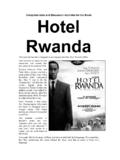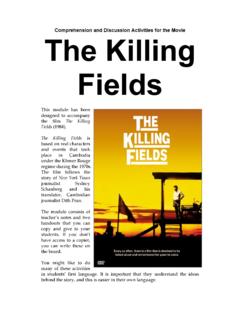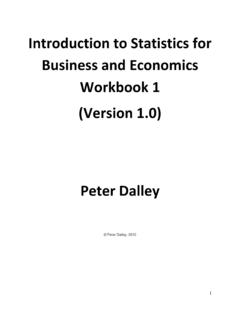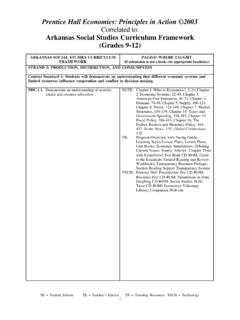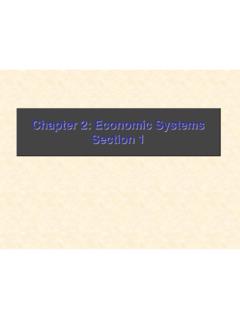Transcription of Economics Module - Teacher's Guide Nov 08 Edition
1 ECONOMICSan introductionTeacher s GuideThe Curriculum ProjectNovember 2008 EditionThe Curriculum Project, Box 114, Mae Sot, Tak 63110, THAILAND this moduleHELLO AND WELCOME TO Economics - AN INTRODUCTION !This Module has been designed for teaching Post-10 learners and adults. Most of themodule is written in intermediate level English. In order to use this Module successfully youneed to think about a few PREPARATIONP robably, like most people, you are not an expert in Economics . So, it will help you a lot if youspend time reading through the Student s Book and the teacher s Guide in detail beforeyou start teaching. This is necessary to help you understand the ideas, the vocabulary andthe teaching methods and you won t understand everything.
2 Don t worry! If you really don t understandsomething, ask another teacher , a friend, or someone else who you think might know, andsee if they can help you. If nobody can help, don t teach that part, but keep thinkingabout it and keep looking for someone to ask. Preparation is also important before eachlesson. You should always make sure you understand exactly what you will teach, and howyou will teach it, before you LANGUAGEA lthough this Module is in English, you should decide on the language that you, and thelearners, will use in the classroom. Ideally you should use the learners first language whenyou explain concepts and meaning (if you can speak their first language, of course!)
3 Forpresentations, comprehensions, and other activities, learners should also be allowed to usetheir first language where possible. If you are using the Module to teach Social Studies andEnglish language skills together, then you can ask them to use English as much as sure that you have at least one dictionary available in the classrrom at all CLASSROOM ORGANISATIONT here are many pairwork and groupwork activities in this Module . Depending on the size ofthe class, and the amount of time you have, you should decide how large the groups shouldbe, or whether learners should work in pairs or groups. The problem with large groups is thatsome learners will not get the chance to participate much in the activity. Also, don t alwaysput students in the same groups or pairs.
4 Change them SELECTING ACTIVITIEST here are a lot of activities in this book. If you don t have much time, you need to decidewhich activities you want to do, and which activities you won t have time for. REMEMBER:you don t have to do everything in the teacher s Guide ! Choose what you think is appropriatefor the amount of time that you have to teach the WORKING WITH TEXTT here is a lot of text in the Student s Book. If possible, try to use a few different ways of readingthe text in class so that you don t always do the same thing. Here are some options:1. Ask learners to read the text on their own and then check their Put learners into pairs and ask them to read the text together and discuss the Ask selected learners to read the text aloud (a paragraph or a sentence) to the rest of theclass and discuss Put learners into pairs or small groups and ask them to read the text and summarise themain points.
5 Then ask one or two groups to explain the main points to the class in their firstlanguage. When they have finished check with the class that they IF YOU DON T LIKE IT, CHANGE IT!If you can think of a better way to do / explain something, or you want to add or removethings, go ahead! You know your learners and your situation better than we Curriculum Project Economics : an introduction - teacher s Guide234 - 55 - 67 - 131415 - 1819 - 2526 - 2930 - 3637 - 4041 - 4344 - 4647 - 4950 - 5253 - 6162 - 6566 - 747576 - 77 ContentsChapter 1 IntroductionChapter 2 Needs &WantsChapter 3 Goods & ServicesChapter 4 Scarcity & ChoiceChapter 5 Money and BarterChapter 6 PriceChapter 7 Supply & DemandChapter 8 InflationChapter 9 TaxChapter 10 ProductionChapter 11 Employment, Working Conditions & LabourUnionsChapter 12 OilChapter 13 economic IndicatorsChapter 14 economic SystemsChapter 15 Global economic InstitutionsChapter 16 International TradeChapter 17 Trade BlocsChapter 18 economic GlobalisationChapter 19 ReviewGlossaryPage(s)November 2008 Edition2 The Curriculum Project Economics : an introduction - teacher s Guide1.
6 Before giving out the Student Books, ask the students: What is Economics ? Put them into groups of 3-5 and ask them to think of words related toeconomics. For example, they might say money or business . Give themabout 5 minutes to think of words. Then, go around each group eliciting oneword and writing it on the board until you have about 15-20 words (or less).Then, ask each student in turn to come up to the board and draw a linebetween any two words on the board and explain why they think they arelinked. For instance, if you drew a line between business and money youmight say, Business is a way of making money. A student can choose thesame two words as a previous learner, as long as they give a different reasonfor the link ( You need money to start a business.)
7 Bring an object to class, perhaps a pen. Ask the class:Where was this made?Answer: A did it go after the factory?Answer: A did it reach the shop?Answer: In a van or did I get it?Answer: You went to the shop and bought did I buy it with?Answer: Your do I use it for?Answer: You use it to write the following concepts:Production - this pen is made in a - the pen is taken to the shop in a van or - you buy and use the out the Student Books and ask students to turn to Page 2. Ask onestudent to read aloud the first bit of dialogue at the beginning of the another student to read the other bit of the difference between need and want :Need - something that is necessary for - something that you desire to have, but is not necessary for students to read the paragraph, What is Economics ?
8 Checkunderstanding. Then look at the section on Ma Ma s Cakes with the one student if he/she can see where production is happening (the factory).Ask another student about distribution (the van and the shop), and onotherabout consumption (buying at the shop and eating the cake).2. Put students into pairs and ask students to draw an economic map foranother product. Give them about 20 minutes. Then ask each pair to cometo the front and briefly explain their economic What Is Economics ?The word Economics comes from two old Greek words - oikon , which means home and nomos which means management . Therefore, Economics literally means management of thehome . However, the meaning is now much larger, meaning the management of all world Curriculum Project Economics : an introduction - teacher s Guide2.
9 Needs and Wants 1. Ask the students to read the instructions. Make sure that everyoneunderstands. Make sure that they understand that there are no otherpeople or buildings on the island, and that they should only write the thingsthat they think they NEED. Divide the class into groups of 3-5 people andgive them about 10 minutes to complete the they have finished, elicit one need from each group in turn. Eachtime, ask whether the rest of the class agrees that it s a need. If they agree,write it on the :to survive (verb): to stay (noun): being students to read the two paragraphs about needs and wants. Makesure they understand that education, healthcare and safety can also beneeds. Also make sure they understand that wants are usually much greaterthan them to look at the cartoon.
10 Tell them that stuff means things . Askthem if any of the things they can see are of the things that are in the picture can really be described as needs , except maybe someof the books which can be included as education , and the clothes in the drawer. People cansurvive without chairs, tennis racquets, pictures, tape recorders, Give students about 5 minutes to write their lists. If the class is very big,you might prefer to put the students into pairs or groups. Ask each student(or pair / group) to read aloud their list. Are any of these things needs?Ask one student to read aloud the paragraph about wealth inequality .3. Is there a lot of wealth inequality in your community? Why? Why not?Who owns the wealth in your community? Why?Elicit opinions from Your OwnDiscussionGroupwork4 The Curriculum Project Economics : an introduction - teacher s Guide3.
